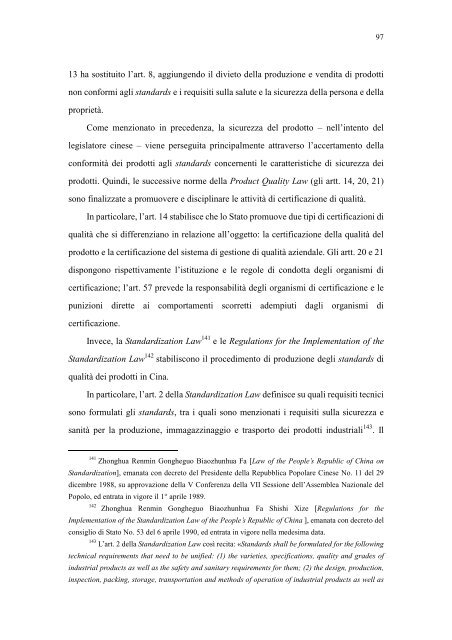la sicurezza dei prodotti e la responsabilità del produttore nella ...
la sicurezza dei prodotti e la responsabilità del produttore nella ...
la sicurezza dei prodotti e la responsabilità del produttore nella ...
Create successful ePaper yourself
Turn your PDF publications into a flip-book with our unique Google optimized e-Paper software.
13 ha sostituito l’art. 8, aggiungendo il divieto <strong>del</strong><strong>la</strong> produzione e vendita di <strong>prodotti</strong><br />
non conformi agli standards e i requisiti sul<strong>la</strong> salute e <strong>la</strong> <strong>sicurezza</strong> <strong>del</strong><strong>la</strong> persona e <strong>del</strong><strong>la</strong><br />
proprietà.<br />
Come menzionato in precedenza, <strong>la</strong> <strong>sicurezza</strong> <strong>del</strong> prodotto – nell’intento <strong>del</strong><br />
legis<strong>la</strong>tore cinese – viene perseguita principalmente attraverso l’accertamento <strong>del</strong><strong>la</strong><br />
conformità <strong>dei</strong> <strong>prodotti</strong> agli standards concernenti le caratteristiche di <strong>sicurezza</strong> <strong>dei</strong><br />
<strong>prodotti</strong>. Quindi, le successive norme <strong>del</strong><strong>la</strong> Product Quality Law (gli artt. 14, 20, 21)<br />
sono finalizzate a promuovere e disciplinare le attività di certificazione di qualità.<br />
In partico<strong>la</strong>re, l’art. 14 stabilisce che lo Stato promuove due tipi di certificazioni di<br />
qualità che si differenziano in re<strong>la</strong>zione all’oggetto: <strong>la</strong> certificazione <strong>del</strong><strong>la</strong> qualità <strong>del</strong><br />
prodotto e <strong>la</strong> certificazione <strong>del</strong> sistema di gestione di qualità aziendale. Gli artt. 20 e 21<br />
dispongono rispettivamente l’istituzione e le regole di condotta degli organismi di<br />
certificazione; l’art. 57 prevede <strong>la</strong> <strong>responsabilità</strong> degli organismi di certificazione e le<br />
punizioni dirette ai comportamenti scorretti adempiuti dagli organismi di<br />
certificazione.<br />
Invece, <strong>la</strong> Standardization Law 141 e le Regu<strong>la</strong>tions for the Implementation of the<br />
Standardization Law 142 stabiliscono il procedimento di produzione degli standards di<br />
qualità <strong>dei</strong> <strong>prodotti</strong> in Cina.<br />
In partico<strong>la</strong>re, l’art. 2 <strong>del</strong><strong>la</strong> Standardization Law definisce su quali requisiti tecnici<br />
sono formu<strong>la</strong>ti gli standards, tra i quali sono menzionati i requisiti sul<strong>la</strong> <strong>sicurezza</strong> e<br />
sanità per <strong>la</strong> produzione, immagazzinaggio e trasporto <strong>dei</strong> <strong>prodotti</strong> industriali 143 . Il<br />
141<br />
Zhonghua Renmin Gongheguo Biaozhunhua Fa [Law of the People’s Republic of China on<br />
Standardization], emanata con decreto <strong>del</strong> Presidente <strong>del</strong><strong>la</strong> Repubblica Popo<strong>la</strong>re Cinese No. 11 <strong>del</strong> 29<br />
dicembre 1988, su approvazione <strong>del</strong><strong>la</strong> V Conferenza <strong>del</strong><strong>la</strong> VII Sessione <strong>del</strong>l’Assemblea Nazionale <strong>del</strong><br />
Popolo, ed entrata in vigore il 1° aprile 1989.<br />
142<br />
Zhonghua Renmin Gongheguo Biaozhunhua Fa Shishi Xize [Regu<strong>la</strong>tions for the<br />
Implementation of the Standardization Law of the People’s Republic of China ], emanata con decreto <strong>del</strong><br />
consiglio di Stato No. 53 <strong>del</strong> 6 aprile 1990, ed entrata in vigore nel<strong>la</strong> medesima data.<br />
143<br />
L’art. 2 <strong>del</strong><strong>la</strong> Standardization Law così recita: «Standards shall be formu<strong>la</strong>ted for the following<br />
technical requirements that need to be unified: (1) the varieties, specifications, quality and grades of<br />
industrial products as well as the safety and sanitary requirements for them; (2) the design, production,<br />
inspection, packing, storage, transportation and methods of operation of industrial products as well as<br />
97
















